Contents
The controversy over the so-called purple, or blue, tomatoes does not stop on the Internet. But the “blue” selection is gradually finding more and more favor among gardeners due to the taste, resistance of varieties and the beneficial properties of tomatoes. It is to these varieties that the Blue Lagoon tomato belongs. What are its unique qualities – in detail in the article.
Description of the tomato variety
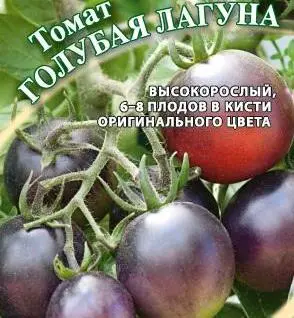
The Blue Lagoon tomato variety is classified as tall, or indeterminate, it was bred by breeders specifically for growing in greenhouses, film greenhouses. The originator of the Blue Lagoon variety is the Moscow company Gavrish; in 2018, the variety was included in the State Register of the Federation and recommended for cultivation in all regions of the country. The manufacturing company focuses on the fact that obtaining a variety was associated with traditional breeding methods, so it is not a GMO.
The Blue Lagoon tomato has a thick stem. The plant of this variety has a branched powerful root system. Tomato leaves are small, their color is dark green. The foliage of the bush is medium.
According to the ripening period, the Blue Lagoon variety is classified as medium-early: the time for the appearance of ripe fruits from the moment of germination is 100 – 120 days.
Description of fruits (shape, color, size, weight, scope of fruits)
The fruits of the Blue Lagoon variety on the bush are strewn with clusters, the tomatoes are flat-round, from 6 to 8 pieces are formed. from each brush. The mass of tomatoes is from 160 to 190 g.
Ripe tomatoes are sweetish in taste, with an aroma rich in light fruity notes.
By appointment, the Blue Lagoon variety is classified as salad. Fruits are recommended to be consumed both fresh in salads and in pickles.
Blue Lagoon tomatoes owe their unusual blue color to anthocyanin pigments. It is their presence that gives the purple-blue color to eggplant, blueberries and blue cabbage. The increased interest in tomatoes of atypical color is associated not only with color, but also with their medicinal capabilities.
A high content of anthocyanins in tomatoes was achieved by long-term selection in order to enhance their antioxidant properties to increase the protective ability against free radicals. It helps with the development of cancer, problems of the cardiovascular system, senile dementia.
The advantages of blue fruits also include an increase in their shelf life up to two times, compared with red ones, and the fact that the activity of enzymes involved in softening the skin during ripening is reduced.
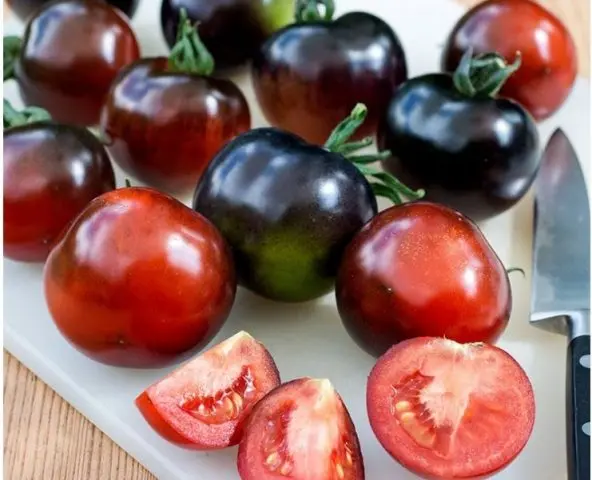
Thus, the fruits of the Blue Lagoon tomato are suitable for transportation over long distances.
Determination of the ripeness of the fruits of the variety is carried out by the top: its yellow color indicates the onset of the phase of technical ripeness, and red indicates the biological one.
Main characteristics
Since the Blue Lagoon variety is classified as indeterminate according to the type of plant, this means that it has no growth restriction, so it needs to be shaped and tied to a support.
The resistance of the Blue Lagoon variety to diseases is also associated with a high content of anthocyanins, which can reduce the softening of fruits when they are overripe. This, in turn, increases the resistance of the plant to such a typical nightshade disease as gray rot (Botrytis cinerea).
The fact is that infection with a gray rot fungus contributes to an “oxidative explosion” in the soft tissues of the fruit. In purple tomatoes, due to their antioxidant capacity, such an oxidative reaction is localized and, due to this, the spread of the fungus is curbed.
The photo demonstrates the experimentally established susceptibility of red areas of fruits, where the key anthocyanin enzyme is absent, to softening and damage by gray rot:
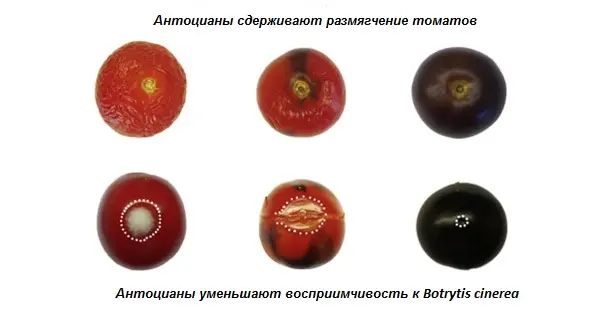

Necessary in any case, the prevention of gray rot and late blight is carried out with special preparations according to the instructions.
Tomato yield Blue Lagoon
The yield of the Blue Lagoon variety is characterized as high and, with regular watering and top dressing, is 10-12 kg per bush.
From the appearance of the first shoots in March to the start of harvesting in July, 3,5 – 4 months pass.
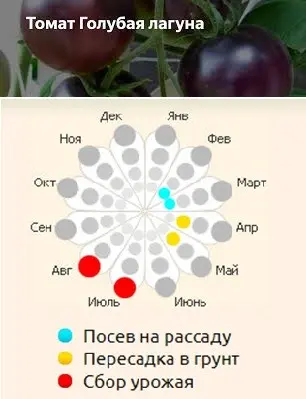
Purple varieties of tomatoes are able to bear fruit until autumn: from July to the end of August.
Advantages and disadvantages
The advantages of the Blue Lagoon tomato variety include:
- resistance to diseases;
- pleasant, without sourness, with notes of fruit, the taste of tomatoes;
- the ability of fruits to be stored for a long time;
- high content of antioxidants;
- ideal characteristics for canning.
The relative disadvantages of the Blue Lagoon variety can be:
- intended only for growing in greenhouses;
- some difficulty in determining ripeness.
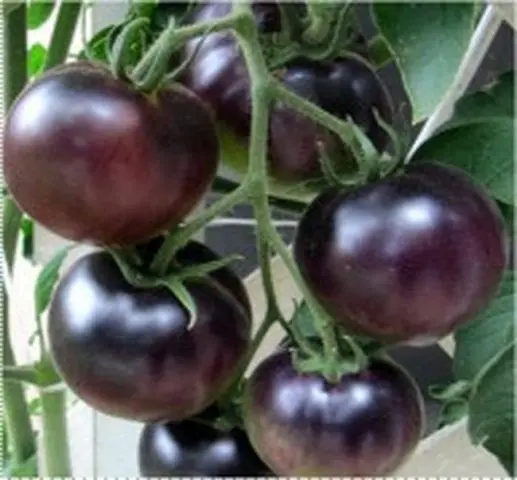
In general, the improved characteristics of the Blue Lagoon tomato variety achieved by breeding methods are their undoubted advantage.
Rules of landing and care
The rules of agricultural technology for tomatoes Blue Lagoon are to perform the following activities:
- Seedling quality should be high.
- You should not save on space: the bushes will grow well with enough space.
- Periodic hilling of tomatoes will create conditions for a sufficient supply of air to the roots.
- Regular watering. Young seedlings require a daily regimen, and for adult plants – from one to three times a week, depending on the humidity of the air. Water the plants under the root, while avoiding wetting the leaves.
- The need for support. The indeterminate bush of the Blue Lagoon variety requires a garter to the trellis, otherwise the development and fruiting of the plant will be difficult.
- Regular feeding. Tomatoes should be fertilized with humus, ash, a solution of chicken manure.
Seeding for seedlings
The term for sowing seeds of the Blue Lagoon variety for seedlings is the end of February – the beginning of March, about 45 days before planting.
For planting, the seed material is soaked in water with the addition of potassium permanganate and kept for 10-15 minutes. This procedure helps to disinfect the seeds and separate the empty seeds from the full ones: the seeds that have sunk to the bottom are wrapped in a damp cloth and left until they give the first sprouts.
For seeds, prepare the soil with the inclusion of:
- 2 parts of peat;
- 1 part of garden land;
- 1 part humus or compost;
- 0,5 pieces of sand.
In addition, the following additives are added to the composition:
- wood ash – 1 tbsp.;
- urea – 10 g;
- superphosphate – 30 g;
- potash fertilizer – 10 g.
The soil mixture is sieved, disinfected by calcination, treatment with a solution of manganese.
After the sprouts from the seeds reach 3-5 mm (approximately in a week), they are planted in a prepared container. For sowing, disinfected containers are used from cassettes, boxes, cups, pots, planters, boxes, and peat cups are also used. Estimated date is mid-March. The containers are filled with soil by more than a third, seeds with sprouts are laid and covered with a 2 cm layer of earth. Cover with film or glass from above.
The glasses are left at an air temperature of 22 ℃ and a humidity of about 80%. The best place in the apartment will be a place next to the heating system. The time of appearance of the first shoots is about a week.
When the first shoots of the Blue Lagoon tomato appear, the film or glass is removed. Seedlings are provided with additional lighting for 16 hours daily, usually with fluorescent lamps. The soil must be moistened as it dries.

The pick is carried out in the phase of the first true leaf. To do this, the plants are thinned out and transplanted into additional containers.
You can clearly see how to grow tomato seedlings in the video:
Seedling transplant
After a month and a half, seedlings of the Blue Lagoon tomato variety will give the first flower brushes, and after another 10-12 days, in late April-early May, it is planted in a greenhouse. Thus, from sowing seeds to planting seedlings is like two months. After a few days, the plants will need a garter.
Seedlings of a variety are considered of high quality if they have strong stems, large leaves, developed roots and developed buds.
The soil for planting a tomato Blue Lagoon is a mixture of peat with garden soil.
For landing, choose a non-solar day and follow the algorithm:
- Dig up a layer of soil to a depth of 25 – 30 cm.
- Holes are formed according to the scheme 40×60 cm.
- Seedlings are placed in the holes, deepening its stems in the soil by 2 cm.
- Dig in and lightly press into the ground at the base.
- Watered with warm, settled water.
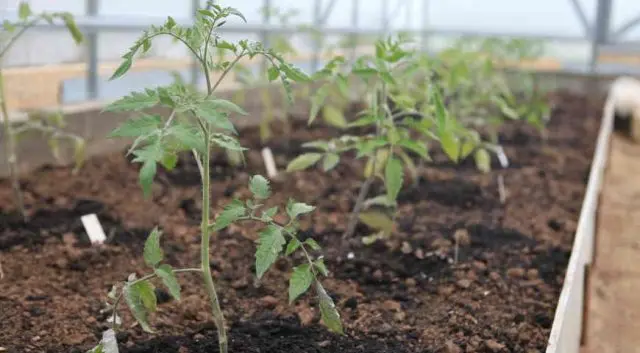
Care of tomatoes
After the tomatoes reach half a meter in height, they are tied up, the support is well strengthened for reliability. The formation of an indeterminate bush is carried out in one stem, with the removal of all stepchildren and lower leaves, and at the end of the growing season, the growth point is pinched.
Stepchildren 5 cm long are broken out or cut out with a disinfected knife. The procedure should be repeated at least once every two weeks.
Basic requirements for the further care of Blue Lagoon bushes:
- the frequency of watering per week is 1 – 2 times, in the morning or in the evening;
- in the greenhouse, tomatoes should be provided with a good ventilation system;
- the recommended humidity regime should not exceed 70%, temperature – 16 – 18 ℃.
After 1,5 weeks from the moment of disembarkation, top dressing is carried out, for which granular superphosphates are used, you can also use a solution of chicken manure. The second feeding is carried out after 2 weeks after the first.
To ensure a uniform blue of the fruit, the brushes are clarified half a month before harvesting. The procedure for lightening the bush consists in cutting the leaves located in the shade: both in the depths of the bushes and facing north: in this way, an improvement in the ventilation of plants is achieved. Ignoring this procedure can lead to partial staining of tomatoes or the absence of blue pigmentation: the fruits will be red.
Conclusion
Tomato Blue Lagoon is an original variety with a purple-blue color and improved breeding characteristics. The high content of anthocyanin pigments in fruits provides disease resistance, keeping quality and beneficial antioxidant properties of tomatoes for the body.









